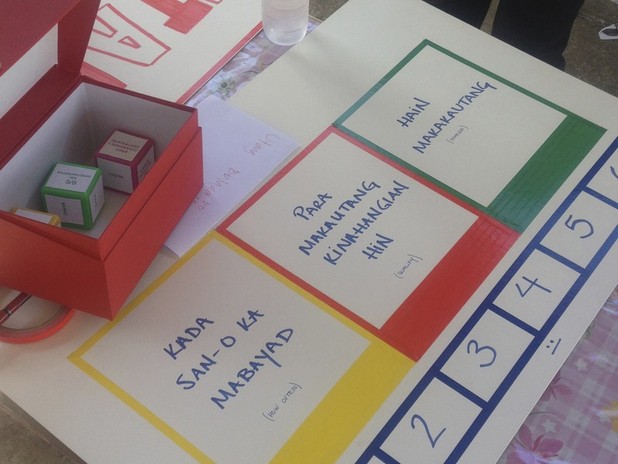May 15, 2014
Working with Mercy Corps and BPI Globe BanKO to bring financial stability to communities of the Philippines, the IDEO.org team members continue their exploration into what loans might look like using a creative research method, called the “Loan Suprise” game.
During Part I of "Loan Surprise" we set out to discover the current situation of loans in rural Leyte. We wanted to learn how people perceived loans. What were their fears or their reasons in selecting a particular type of loan over another? Once we had gained a better understanding of the current landscape of loans, we began adapting it to test our own hypotheses. We played the same game, but this time included loan options and qualifications. This turned into the "Loan Surprise” Game: Part II where our design team took the first step from research to rapid prototyping.
What we changed
Using the same giant dice we had made with existing loan scenarios, we simply changed the information presented on each face to include some new, often fictional scenarios.
For example, with the die that was previously labeled with different sources of loans (i.e. "Loan Shark (5-6)", "Bank", "Brother"), we added some new ones. These included “5/6" (which is what loan sharks are called), “10/11” (which doesn't exist), “10%” (mathematically equally to a 10/11), and “20%” (mathematically equal to a 5/6 loan). We repeated the same type of loan with different names to see if people would gravitate towards one over the other. We were also curious to see if people would mentally do the math from their knowledge of a 5/6 and make the connection to the interest rate they pay.
What we learned
Through this adaptation, we learned that when it comes down to it, interest rate is only a minor consideration when taking out a loan. It may come up often because it's an easy number to talk about, compare, and attempt to negotiate. But at the end of the day, if the loan has other appealing characteristics the interest takes a back seat in the decision-making process. We also learned that lowering the entry barriers to taking out a loan is a much more appealing to people than lowering the interest rate.
We learned that the 10/11 loan (our made up loan) was most popular because it was a direct comparison, and therefore a direct competitor, to the existing 5/6. People would not calculate the math on it, but would immediately associate it to being a better option. Loans are popular when they are more accessible than the bank loans and have a payment schedule that fits the needs of the unreliable post typhoon market. People take out 5/6 loans because they feel it's their only accessible option, and only use it during emergencies.
Why this counts
Once we changed the faces of the dice, we weren't looking to uncover the current landscape of loans. This time we were looking to see how people reacted to new loan scenarios and how they navigated and negotiated the terms of a new hypothetical loan. It was the first step we took towards moving from research to early prototyping, which was important because it gave us a solid base to create more refined prototypes for the following days in the field.
Bonus Round
"What's the line of cards at the bottom of the Loan Surprise Game?" (See second photo)
Though this last piece to the game is not required, you may find it useful to add. We drew the numbers from 1 to 6 on the bottom of the board and had a set of cards with illustrations of various assets. Towards the end of the session with each person we told them that this hypothetical loan would have consequences in the case of non-payment. We then asked them to rank these cards from the first thing they were willing to do or give up to "the worst possible thing we could ever ask you to do".
We learned many nuances about value with this exercise, most evidently the importance of reputation as one of the biggest drivers. The items were ranked in the order of value to the family, usually leaving kitchenware almost last given its core role in subsistence for the family. The chicken was at times included as well because "what's the point of having a pot without having a chicken to put in it?" Community service was popular and never seen as a punishment but as a valid avenue where you could give back what you owe. The second to last item was always the same: jail. And what may come as a surprise is the last card. What was the worst possible punishment for many participants? Being ask to sing publicly at the town plaza!




